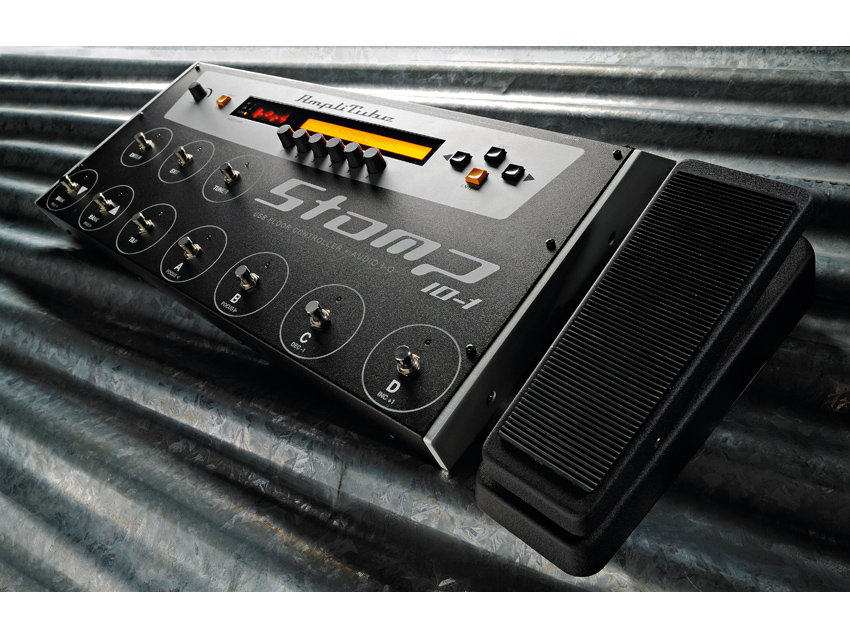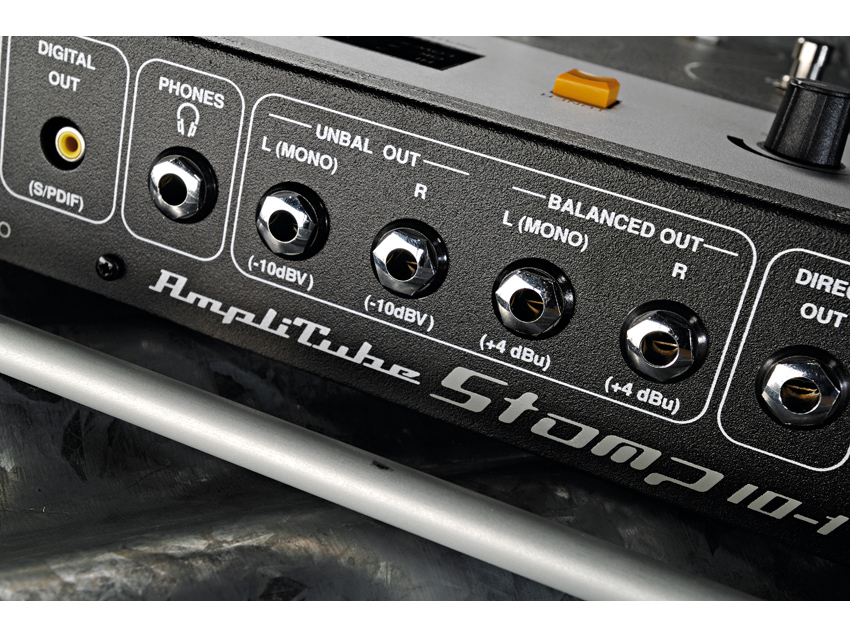MusicRadar Verdict
The best system yet conceived for taking computer-based amp and effects sounds into a live playing situation.
Pros
- +
Great array of playable sounds. X-Gear enables new model combinations. Comprehensive and expandable switching faciilities. Solid construction.
Cons
- -
Slight glitchiness when switching between some programs.
MusicRadar's got your back

IK Multimedia StompIO

StompIO is a heavy-duty floor controller that connects to your computer by USB and takes charge of any AmpliTube amp and effects software that you are running. It comes complete with AmpliTube2, AmpliTube Jimi Hendrix, Ampeg SVX (for bass players) plus, for people who already own AmpliTube 2, the new AmpliTube Metal.
Up until now, the various versions of AmpliTube had been mutually exclusive in that you couldn't, say, combine the fuzzbox models in the Hendrix edition with an amp from AmpliTube 2. However, there's now a 'shell' program called AmpliTube X-Gear - included in the StompIO package - that ties all of them together and enables you to mix and match.
StompIO is built to withstand the rigours of the road - its metal construction is as solid as they come, with a tubular 'handle' making it easy to pick up and also protecting, to an extent, all of the rear panel connections. These include MIDI I/O, S/PDIF, stereo headphone jack, two pairs of outputs and a direct jack output for a clean unprocessed version of the input signal.
There are also six sockets to connect external controllers. One of these is used for the Cry Baby clone expression pedal that comes with the package
The top panel controls are well laid out and have been kept simple. The main row of seven foot switches includes bank up and bank down, tap tempo and A, B, C and D switches to select one of the four programs held in each bank. Three extra switches are foot operated duplicates of top panel buttons for exit and entry in data control and for calling up the tuner. A single knob sets the output volume.
The narrow but brightly-lit main display window shows the program name and the parameters editable by a row of six 'soft' knobs directly underneath - ideal for quick onstage tone adjustments. A pair of cursor buttons completes the vast array of controls
There are five modes of operation for the StompIO. Called play modes, each offers a different set of functions for the bank up/down and A, B, C and D switches.
In use
With X-Gear running and StompIO connected via USB, the sound of the software amp sims is available at the StompIO outputs, ready to go to headphones, PA or a power amp/speaker combination.
IK has considered all the options when designing the various StompIO Play modes - there are different ways of working to suit different players, but one thing that they all have in common is that a large degree of organisation has to take place before taking the StompIO onstage. You have to edit programs to get the sounds you want and then put them into the StompIO memory banks in a logical order for easy recall when needed.
Switching directly between programs while playing can, in cases where the two sounds are very different from each other, come across as a little unnatural with a short, but still perceptible, silent gap between sounds which can seem like a time lag before the start of the new sound. This is something to be aware of, and requires careful timing when hitting the switch, but may not necessarily be a problem as most switching of that nature is likely to occur between songs or at natural gaps in the music.
Users are also likely to program sounds that fit together in a song where the tonal and volume differences between programs are not so pronounced, ensuring a smoother transition. IK tells us that a future software update will allow a reverb tail to be carried over during the patch change, so the first sound will not seem to end abruptly.
Stomp mode seems the most familiar and practical way to work for anyone used to a standard pedal setup and smooth switching. With four stompboxes assigned to the four switches you could always use the same effect assigned to a particular switch - perhaps wah, overdrive, chorus and delay to keep things simple - but if you don't do that the display can be set to show which effect is assigned to which switch.
Each switch can actually be programmed to control up to four parameters at once so, rather than switching a single effect, there is plenty of complexity available should you need it, notwithstanding the possibility of adding up to six more switches and pedals.
Recording
IK sees the StompIO as primarily for live use but the package also offers plenty of scope for recording. The quickest and easiest way to record while taking advantage of the StompIO switching and pedal facilities is to record out of its outputs into a separate audio interface while running X-Gear in standalone mode.
You can also use the StompIO as your audio interface and record directly via USB using X-Gear as a plug-in in the recorded track. In this situation, although the StompIO is controlling the plug-in and you can monitor the processed sound perfectly, you are recording just the dry guitar sound that will be processed by a plug-in at mixdown and not actually recording any program changes or pedal actions via the USB connection.
IK Multimedia tells us that this will be addressed in an X-Gear software revision (possibly out by the time you read this) that will enable plug-in automation data to be recorded alongside the audio (although not the program changes). IK suggests that the best way to work, however, is to record two tracks at once - using the output of the first track (with the X-Gear plug-in) as the input of the second. That way you will get one unprocessed guitar track and one with the fully processed sound including all sound changes made with the StompIO.
Summary
StompIO gives you a huge number of models and a tool to control them in one package. It doesn't come cheap though, and if the price doesn't scare you maybe the thought of using a computer-based amp and effects rig onstage does. If, however, you are willing to take the plunge you will be rewarded with an extremely versatile and expandable system that integrates the guitar and the computer seamlessly.
Have a listen to the X-Gear software in action:
MusicRadar is the number one website for music-makers of all kinds, be they guitarists, drummers, keyboard players, DJs or producers...
- GEAR: We help musicians find the best gear with top-ranking gear round-ups and high-quality, authoritative reviews by a wide team of highly experienced experts.
- TIPS: We also provide tuition, from bite-sized tips to advanced work-outs and guidance from recognised musicians and stars.
- STARS: We talk to musicians and stars about their creative processes, and the nuts and bolts of their gear and technique. We give fans an insight into the craft of music-making that no other music website can.
“We were arguing a lot and we were miserable”: How Green Day exceeded expectations with their most ambitious song
"There’s plenty for us guitarists to learn – and ‘less is more’ is the overriding lesson": how to play like George Harrison on The Beatles' Abbey Road
“They didn’t like Prince’s bikini underwear”: Prince’s support sets for the The Rolling Stones in 1981 are remembered as disastrous, but guitarist Dez Dickerson says that the the crowd reaction wasn’t as bad as people think










